|
1951
- UNIVAC
The
Universal Automatic Computer (UNIVAC) was a large and expensive
system that used stored data on tape, not cards. Unlike many other
productions this machine was not a collection of different devices.
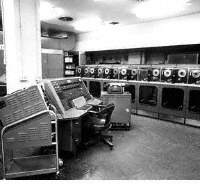
UNIVAC
1
(Image
courtesy of Computer History Museum)
The UNIVAC's
innovative internal design was a 'stored program' computer and
was one of the first to be made. The UNIVAC was different from
other machines as it was designed to replace.
Universal
implied that it could solve problems encountered by scientists,
engineers and businesses.
Automatic
implied that it could solve complex problems without requiring
constant human intervention. This was the use of tape in place
of punch cards.(Ceruzzi. P., 1998).
As such
the UNIVAC was regarded as an information processing system by
its customers. Not only did it replace existing calculating machines,
but also the people who tended them. (Ceruzzi. P., 1998)

Gordon
Riocreux talks about his first experience of computers and attending
a computer programing course
The
early 1950's saw the introduction of commercial computers.
1953
- EDSAC
EDSAC
of Cambridge University was the first computer to be commercialized.
J. Lyons and Company LTD took the EDSAC design converted it for
their own business applications. This development project turned
into a new computer company, LEO Computers Ltd.

Gordon
Riocreux remembers working with the first programs to be developed
at High Holborn
1954
-
IBM 650
This
magnetic drum calculator was the first mass produced computer,
selling 450 in one year. The device allowed much faster access
to material stored in the memory.
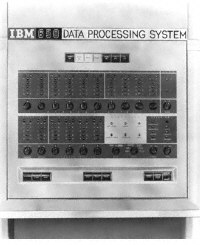
IBM
650
(Image
courtesy of Computer History Museum)
1955
- User Groups
The
first meeting of IBM's user group SHARE. Following this 'user
groups' became a significant educational force, as it allowed
companies to communicate innovations and users to trade information.
(Computer History Museum).

Gordon
Riocreux talks about the first computer programs he worked with
1956
- Transistors
Although
first invented in 1948, it wasn't until now that they began to
work in the computer. The MIT TX-0 was the first general purpose
computer built with transistors.
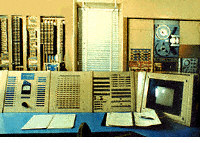
MIT
TX-0
(Image
courtesy of Computer History Museum)
1957
- FORTRAN
FORmula
TRANslator. Although development of software and languages had
been going on for many years FORTRAN language enabled a computer
to perform a repetitive task from a single set of instructions,
using loops.
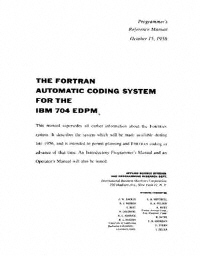
FORTRAN
(Image
courtesy of Computer History Museum)
1958
- Integrated Circuits
The integrated
circuit was created by Jack Kilby, USA. It proved that resistors
and capacitors could exist on the same piece of semi-conductive
material.

Integrated
Circuit
(Image
courtesy of Computer History Museum)
1959
- IBM's 7000
The creation
and production of this series of mainframe computers was the company's
first transistorized computers.
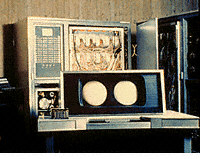
IBM
STRETCH (In background) - This is the IBM 7030, at the the top
of the line in the 7000 series
(Image
courtesy of Computer History Museum)
|

![]()
